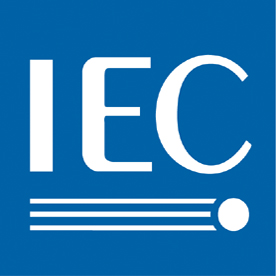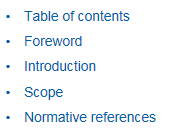ISO/IEC 5218:2004 Withdrawn
Information technology -- Codes for the representation of human sexes
Abstract
ISO/IEC 5218:2004 specifies a uniform representation of human sexes for the interchange of information. It provides a set of numeric codes that are independent of language-derived codes and as such is intended to provide a common basis for the international exchange of information containing human sex data.
In providing numeric codes for the representation of human sexes, ISO/IEC 5218:2004 aims to:
As such, ISO/IEC 5218:2004 meets the requirements of most applications that need to code human sexes.
ISO/IEC 5218:2004, however, does not supplant national standards for coding sexes based on codes derived from names of sexes in various languages, nor does it provide codes for sexes that may be required in specific medical or scientific applications or in applications that need to code information on sex other than for human beings.
Annex A provides an illustrative and easy to understand example for addressing how the three strategic directions of ISO/IEC JTC1, namely "portability", "interoperability", and "cultural adaptability", can inter-work. The rise in the use of the Internet underscores the validity for the need of such an approach.
Annex A also provides an example of unique unambiguous referencing and identification of a semantic component: (1) among heterogeneous IT systems, i.e., at the IT interface; and, (2) with multiple human interface equivalents, be they of a linguistic, symbolic, multimedia, etc., nature. This human interface also includes the provision for the requirements for the disabled using Braille, Bliss, etc.
Annex A concludes with a representation, in XML, of the multiple human interface (linguistic) equivalents for the four numeric codes of ISO/IEC 5218:2004, focusing on the different languages of countries participating in the work of ISO/IEC JTC1/SC32.
,
L'ISO/CEI 5218:2004 spécifie une méthode de représentation uniforme des sexes humains pour l'échange d'information. Elle propose un jeu de codes numériques indépendant des codes dérivés dans les diverses langues et qui, de ce fait, offre une base commune pour l'échange international des données élémentaires relatives aux sexes humains.
L'ISO/CEI 5218:2004, en fournissant les codes numériques pour la représentation des sexes humains, a pour but de
réduire le temps nécessaire pour enregistrer et/ou mettre en forme la représentation des sexes et transmettre les données qui y correspondent,
accroître l'intégrité, la clarté, et la fiabilité des échanges,
diminuer la somme des interventions humaines nécessaires pour communiquer la représentation des sexes, et
réduire les coûts reliés à l'utilisation et à l'échange de l'information.
L'ISO/CEI 5218:2004 répond aux exigences de la plupart des applications qui nécessitent la codification des sexes humains.
Néanmoins, l'ISO/CEI 5218:2004 ne se substitue pas aux normes nationales relatives à la codification des sexes employés dans les diverses langues. Elle ne détermine pas de codes pour les sexes qui pourraient être requis dans des applications spécifiquement médicales ou scientifiques, ou dans des applications qui nécessiteraient une information codée des sexes autres que ceux êtres humains.
L'Annexe A a été ajoutée pour illustrer et offrir un exemple simple et compréhensible qui réponde aux orientations stratégiques énoncées par l'ISO/CEI JTC1, à savoir «la portabilité», «l'interopérabilité», et «l'adaptabilité culturelle», et démontrer comment ces trois orientations peuvent fonctionner ensemble. L'augmentation de l'utilisation de l'internet justifie de façon évidente le besoin d'une telle approche.
L'Annexe A présente également un exemple de référencement et d'identification sans ambiguïté d'une composante sémantique: (1) parmi les systèmes IT hétérogènes, c'est-à-dire au niveau de l'interface IT; et, (2) avec les équivalents interfaces humaines, qu'ils soient de nature linguistique, symbolique, multimédia, etc. Cette interface humaine inclut également les dispositions nécessaires prévues pour les handicapés utilisant le Braille, le BLISS, etc.
Finalement, l'Annexe A conclut avec une représentation, en XML, des équivalents interface humaine (linguistiques) pour les quatre codes numériques de l'ISO/CEI 5218:2004 axée sur les différentes langues des pays participant aux travaux de l'ISO/CEI JTC1/SC32.
In providing numeric codes for the representation of human sexes, ISO/IEC 5218:2004 aims to:
- reduce the time required to record, format, and transmit the information;
- improved the integrity, clarity and accuracy of the interchanged information;
- minimize the amount of human intervention required for communicating the information; and,
- reduce costs related to the use and exchange of the information.
As such, ISO/IEC 5218:2004 meets the requirements of most applications that need to code human sexes.
ISO/IEC 5218:2004, however, does not supplant national standards for coding sexes based on codes derived from names of sexes in various languages, nor does it provide codes for sexes that may be required in specific medical or scientific applications or in applications that need to code information on sex other than for human beings.
Annex A provides an illustrative and easy to understand example for addressing how the three strategic directions of ISO/IEC JTC1, namely "portability", "interoperability", and "cultural adaptability", can inter-work. The rise in the use of the Internet underscores the validity for the need of such an approach.
Annex A also provides an example of unique unambiguous referencing and identification of a semantic component: (1) among heterogeneous IT systems, i.e., at the IT interface; and, (2) with multiple human interface equivalents, be they of a linguistic, symbolic, multimedia, etc., nature. This human interface also includes the provision for the requirements for the disabled using Braille, Bliss, etc.
Annex A concludes with a representation, in XML, of the multiple human interface (linguistic) equivalents for the four numeric codes of ISO/IEC 5218:2004, focusing on the different languages of countries participating in the work of ISO/IEC JTC1/SC32.
,
L'ISO/CEI 5218:2004 spécifie une méthode de représentation uniforme des sexes humains pour l'échange d'information. Elle propose un jeu de codes numériques indépendant des codes dérivés dans les diverses langues et qui, de ce fait, offre une base commune pour l'échange international des données élémentaires relatives aux sexes humains.
L'ISO/CEI 5218:2004, en fournissant les codes numériques pour la représentation des sexes humains, a pour but de
réduire le temps nécessaire pour enregistrer et/ou mettre en forme la représentation des sexes et transmettre les données qui y correspondent,
accroître l'intégrité, la clarté, et la fiabilité des échanges,
diminuer la somme des interventions humaines nécessaires pour communiquer la représentation des sexes, et
réduire les coûts reliés à l'utilisation et à l'échange de l'information.
L'ISO/CEI 5218:2004 répond aux exigences de la plupart des applications qui nécessitent la codification des sexes humains.
Néanmoins, l'ISO/CEI 5218:2004 ne se substitue pas aux normes nationales relatives à la codification des sexes employés dans les diverses langues. Elle ne détermine pas de codes pour les sexes qui pourraient être requis dans des applications spécifiquement médicales ou scientifiques, ou dans des applications qui nécessiteraient une information codée des sexes autres que ceux êtres humains.
L'Annexe A a été ajoutée pour illustrer et offrir un exemple simple et compréhensible qui réponde aux orientations stratégiques énoncées par l'ISO/CEI JTC1, à savoir «la portabilité», «l'interopérabilité», et «l'adaptabilité culturelle», et démontrer comment ces trois orientations peuvent fonctionner ensemble. L'augmentation de l'utilisation de l'internet justifie de façon évidente le besoin d'une telle approche.
L'Annexe A présente également un exemple de référencement et d'identification sans ambiguïté d'une composante sémantique: (1) parmi les systèmes IT hétérogènes, c'est-à-dire au niveau de l'interface IT; et, (2) avec les équivalents interfaces humaines, qu'ils soient de nature linguistique, symbolique, multimédia, etc. Cette interface humaine inclut également les dispositions nécessaires prévues pour les handicapés utilisant le Braille, le BLISS, etc.
Finalement, l'Annexe A conclut avec une représentation, en XML, des équivalents interface humaine (linguistiques) pour les quatre codes numériques de l'ISO/CEI 5218:2004 axée sur les différentes langues des pays participant aux travaux de l'ISO/CEI JTC1/SC32.
Additional information
| Publication type | International Standard |
|---|---|
| Publication date | 2004-07-08 |
| Withdrawal date | 2022-06-01 |
| Edition | 1.0 |
| Available language(s) | English/French |
| TC/SC | ISO/IEC JTC 1/SC 32 - Data management and interchangerss |
| ICS | 35.040.50 - Automatic identification and data capture techniques |
| Stability date | 2022 |
| Pages | 17 |
| File size | 264 KB |
The following test report forms are related:
Share your publications
Learn how to share your publications with your colleagues, using networking options.
Payment information
Our prices are in Swiss francs (CHF). We accept all major credit cards (American Express, Mastercard and Visa, JCB and CUP), PayPal and bank transfers as form of payment.
Keep in touch
Keep up to date with new publication releases and announcements with our free IEC Just Published email newsletter.
Contact customer services
Please send your enquiry by email or call us on +41 22 919 02 11 between 09:00 – 16:00 CET Monday to Friday.

